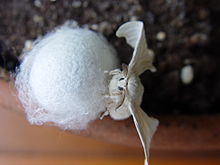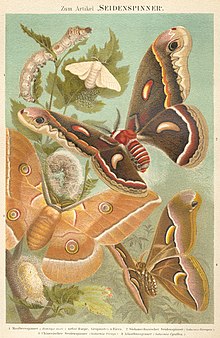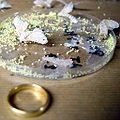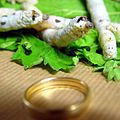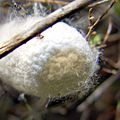Silkworms
| Silkworms | ||||||||||
|---|---|---|---|---|---|---|---|---|---|---|

Silk moth ( Bombyx mori ): male, female, caterpillar, cocoon, pupa |
||||||||||
| Systematics | ||||||||||
|
||||||||||
| Scientific name | ||||||||||
| Bombyx mori | ||||||||||
| ( Linnaeus , 1758) |
The silkworm or silkworm ( Bombyx mori ) is an original in China beheimateter butterfly from the family of Real Spinner (Bombycidae). The silkworm was domesticated by the wild silk moth ( Bombyx mandarina ), which is native to northern India, northern China, Korea, Japan and the Far Eastern regions of Russia. The domesticated silkworm is more likely to come from China than from Japan or Korea. Humans used the abilities of the silk moth's caterpillars , the "silk worms", to produce silk from an early age ; Silkworms were already bred in China 5000 years ago. Due to the spread of silk production (silk construction) it has been spread outside of its original habitat to this day, including in southern Europe.
Silkworms
The silk moth is 32 to 38 millimeters wide, powdery white or pearl gray, has pale yellow-brown horizontal stripes on the wings and blackish combed antennae .
The mating of the butterflies takes six to eight hours. Then the female lays around 400 eggs in a few days and then dies. The eggs, which are yellow at first, soon become darker and finally gray. They are then oval, flattened, 1 to 1.5 millimeters long and colored slate gray, with the color sometimes playing into bluish, purple or greenish tones. Unfertilized eggs stay yellow and dry out. The silkworms hatch from the fertilized eggs after overwintering.

Various other butterfly species are also referred to as silk moths, which are also used to obtain silk. These include the tree of gods spinner ( Samia cynthia ), which feeds on the leaves of the tree of gods ( Ailanthus altissima ).
The following species are known as silk moths:
- Silk moth ( Bombyx mori ) with caterpillar, web and eggs
- Hyalophora cecropia
- Chinese oak silk moth ( Antheraea pernyi )
- Japanese oak silk moth ( Antheraea yamamai )
- Antheraea mylitta , A. roylei , A. proyeli , A. paphia , A. frithi
- Antheraea assama
- Tree of God Spinner ( Samia cynthia )
- Atlas moth ( Attacus atlas )
- Circula trifenestrata
- Gonometa postica , Gonometa rufobrunnea
- Anaphe panda (Syn .: Anaphe infracta ), Anaphe moloneyi (Syn .: Epanaphe moloneyi ) u. a.
Silkworms
The silkworm is the larva of the silk moth. The caterpillar is pearl gray after the first molt, partly, partly tending to brown to yellow. Some forms are blackish gray or velvet black or with dark stripes all over the body. The eleventh body segment has a skin cone (spur) on the back and a bluish-gray band runs from the head to this cone, corresponding to the dorsal vessel or heart. On the back of the third and eighth ring there are two crescent-shaped spots, which are missing in some breeds .
The silkworm moults four times and is ready to spin 30 to 35 days after hatching from the egg. The caterpillar's spinning glands consist of a tube that is wound many times, the rear part of which secretes the silk substance made up of proteins . The silk material is conducted through thin ducts to the spinneret in the head and from there out of the body. The substance emerging from the spinneret immediately hardens to a thread in the air. By making targeted head movements when the material emerges, the caterpillar wraps thread turn by thread turn around itself. After the initial release of an irregular, loose fiber mass, the “watt silk”, it is quickly enclosed in a dense web of silk, the cocoon. This cocoon consists of a single thread up to 900 meters long. The cocoon is elongated-oval, in the native breeds straw yellow, in the Japanese breeds greenish, in the white spiders white. Eight days after spinning , the silkworm pupates , after a further eight days the butterfly hatches, dissolving the cocoon at one point with a brownish liquid.
Diseases
The silkworm is quite susceptible to parasitic diseases (probably a consequence of the long domestication ):
- Blotchiness (Pébrine's disease, nosemosis ) caused by the microsporidia Nosema bombycis ;
- Lime addiction caused by the mold Botrytis bassiana (or Beauveria bassiana );
- Jaundice (polyhedron disease, borreliosis), caused by the borrelia Borrelina bombycis ;
- Flacherie (Flacherie, unexplained cause ).
Various insects (mainly beetles and butterflies ) are also known to be silkworm pests .
Use for silk production
See sericulture and silk .
Raw silk
Man makes use of the silkworm's ability to produce silk yarn. To win the yarn , the pupae are killed with boiling water or hot steam around the tenth day after the cocoon is completed. The spinning thread is carefully unwound and carefully cleaned before further processing in the silk weaving mill.
Producing countries
The caterpillars are bred for silk in China , Cambodia , Vietnam , Japan , India , southern Europe and, since the 1950s, by Japanese immigrants in Brazil . Thanks to its industrial production and excellent climatic conditions, Brazil is now a major silk producer. By crossing the silk threads, you get different colors, such as golden yellow and other nuances. The caterpillars feed exclusively on the leaves of the mulberry trees , which were cultivated for their breeding and also imported to Europe .
Silk cocoons in peeling, in the production of silk
Use as food

In Asia, silk moths are used as food insects : where there is silk production, the larvae of the silk moth contained in the cocoons are used as food after the cocoons have been boiled.
Scientific importance
The silk moth Bombyx mori was the research object of the biochemist Adolf Butenandt . In 1959 he discovered its sex attractant bombykol . The genome of the silk moth was sequenced in 2004 .
Various transgenic silkworms have been bred, either to improve the quality of the silk or to produce fluorescent silk, including to obtain human collagen from it.
Others
Silkwormgut is made from the caterpillar's spinneret, which contains the embryonic silk . This was (is again) used as medical suture material, it is also used in fly fishing .
The British electro-pop group The Human League dedicated the song Being Boiled to the death throes of the silkworm doll in 1978 . The beginning is translated into German something like: “Listen to the Buddha's voice that says: Stop raising silkworms! Little people (meaning the silkworm pupae) like your own offspring are cooked alive for someone's socks ”.
literature
- Friedrich Haberlandt: Brief instructions for rearing the common silkworm. Goertz , 1871, OCLC 780700562 .
- Friedrich Haberlandt : The silk moth of the mulberry tree, its rearing and its diseases. VDM, Saarbrücken 2007, ISBN 978-3-8364-1729-7 (reprint of the Vienna 1871 edition).
- Luciano Pigorini, Fritz Bock: The silk moth: their zoology, biology and breeding. Springer, Berlin 1938, reprint 2014, ISBN 978-3-642-91274-0 .
Web links
- Silk Moth at the National Center for Biotechnology Information (NCBI)
- Silkworms. In: Portal for butterflies / caterpillars. (Photos)
Individual evidence
- ↑ Wolf Herre, Manfred Röhrs: Pets - seen from a zoological perspective. 2nd edition, Springer-Verlag, 1990, ISBN 978-3-642-39394-5 , p. 81.
- ↑ RKDatta: Global Silk Industry: A Complete Source Book. APH Publishing, 2007, ISBN 978-81-313-0087-9 , p. 179.
- ↑ K. Babu Murugesh: Silk: Processing, Properties and Applications. Elsevier, 2013, ISBN 978-1-78242-158-0 , p. 5 f.
- ↑ a b P. N. Pandey: Silk Culture. APH Pub. 2005, ISBN 81-7648-826-7 , p. 3.
- ↑ a b c Sara Lamb: The Practical Spinner's Guide - Silk. Interweave, 2014, ISBN 978-1-62033-520-8 , p. 18.
- ↑ Ryszard M Kozłowski: Handbook of Natural Fibers: Types, Properties and Factors Affecting Breeding and Cultivation. Woodhead Publishing, 2012, ISBN 978-1-84569-697-9 .
- ↑ Silkworms. In: Meyers Konversations-Lexikon von 1888. 14, p. 827.
- ↑ Kazuei Mita et al. a .: The genome sequence of silkworm, Bombyx mori . In: DNA Research . tape 11 , no. 1 , 2004, p. 27-35 , doi : 10.1093 / dnares / 11.1.27 .
- ↑ Masahiro Tomita, Hiroto Munetsuna, Tsutomu Sato and others. a .: Transgenic silkworms produce recombinant human type III procollagen in cocoons. In: Nature Biotechnology. 21 (1): 52-6, 2003, doi : 10.1038 / nbt771 .
- ↑ T. Iizuka, H. Sezutsu, K.-i. Tatematsu et al. a .: Colored Fluorescent Silk Made by Transgenic Silkworms. In: Adv. Funct. Mater. 23: 2013, 5232–5239, doi : 10.1002 / adfm.201300365 .
- ↑ Yoshihiko Kuwana, Hideki Sezutsu, Ken-ichi Nakajima and others. a .: High-Toughness Silk Produced by a Transgenic Silkworm Expressing Spider (Araneus ventricosus) Dragline Silk Protein In: PLOS ONE . 9 (8): e105325., 2014, doi : 10.1371 / journal.pone.0105325 .
- ^ Jose Luis Cenis, Salvador D. Aznar-Cervantes, Antonio Abel Lozano-Pérez and others. a .: Silkworm Gut Fiber of Bombyx mori as an Implantable and Biocompatible Light-Diffusing Fiber. In: Int. J. Mol. Sci. 17 (7), 2016, 1142; doi : 10.3390 / ijms17071142 , online (PDF; 10.25 MB), at mdpi.com, accessed on March 24, 2017.
- ↑ Monika Franziska Maria Flury: Historical roots of the various suture material properties. Dissertation, Julius-Maximilians-Universität Würzburg, Würzburg 2002, DNB 969152930 , online (PDF; 6.51 MB), at opus.bibliothek.uni-wuerzburg.de, accessed on March 24, 2017.
- ↑ Darrel Martin: The Fly-Fisher's Craft. Augumented Edition, Skyhorse Publishing, 2016, ISBN 978-1-5107-0373-5 .
- ↑ Karuna K. Chatterji: A Handbook of Operative Surgery and Surgical Anatomy. Third Edition, Butterworth, 1936, Elsevier, 2016, ISBN 978-1-4831-9907-8 (reprint), p. 5.
